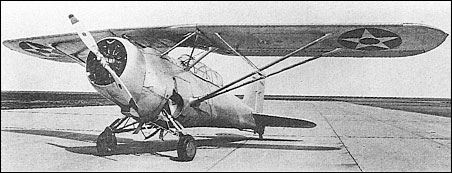|
| Based on a US Navy Bureau of Aeronautics design for a
two-seat fighter, the XF12C-1 all-metal parasol monoplane,
ordered on 30 June 1932, featured aft-folding
wings with leading-edge slats and trailing-edge flaps,
and manually-operated retractable main undercarriage
members. Flown in July 1933, the XF12C-1 was initially
powered by a Wright R-1510-92 two-row radial rated at
625hp at 1830m. By the time the XF12C-1
was tested by the US Navy in October 1933, the Twin
Whirlwind engine had been replaced by a Wright
SR-1820-80 Cyclone single-row radial. With the discarding
of the two-seat fighter category it was redesignated XS4C-1 in December 1933 and the XSBC-1 in January
1934 as a scout-bomber. It crashed during a preliminary
demonstration on 14 June 1934, subsequently being replaced
by the XSBC-2 biplane.
 | A three-view drawing (1278 x 864) |
| MODEL | XF12C-1 |
| WEIGHTS |
| Empty weight | 1762 kg | 3885 lb |
| DIMENSIONS |
| Wingspan | 12.65 m | 42 ft 6 in |
| Length | 8.86 m | 29 ft 1 in |
| Height | 3.94 m | 13 ft 11 in |
| Wing area | 25.27 m2 | 272.00 sq ft |
| PERFORMANCE |
| Max. speed | 349 km/h | 217 mph |
| Range | 1188 km | 738 miles |
| damn, 20.06.2011 12:19 It crashed during a preliminary demonstration on 14 June 1934, subsequently being replaced by the XSBC-2 biplane. reply |
|
Do you have any comments?
|
| 
COMPANY
PROFILE
All the World's Rotorcraft
|







